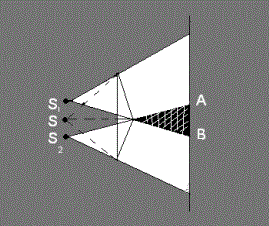Interference of light is a physical phenomenon that occurs when two or more light waves intersect or overlap with each other.
In the interference of light, both constructive and destructive wave interactions can be observed, leading to various phenomena such as light bands, color variations, or spots on surfaces.
To obtain a stable interference pattern, it is necessary for the composing waves to be coherent. Coherent waves are those with the same frequency (period) and a constant phase difference over time. To achieve coherent waves, it is necessary to “split” the light wave from a single source into two or more waves. After traversing different paths, these waves, having some path length difference, interfere.
Scheme of obtaining interference using a Fresnel biprism.
Fresnel biprism is an optical device for obtaining a pair of coherent light beams, proposed by Augustin-Jean Fresnel. The biprism consists of two identical right-angled triangular prisms with very small refractive angles, joined by their bases. In practice, biprisms are usually made from a glass plate.
The wave coming from the light source splits due to the refraction of light in the two halves of the biprism. The resulting waves 1 and 2, as if coming from two imaginary sources S1 and S2, are coherent. Therefore, interference is observed in the shaded region. An interference pattern is observed on the screen segment AB. Interference of light.

Light interference is an important phenomenon in optics and experiments, and it is used to measure the wavelength, create interferometers for highly sensitive measurements, and generate various optical effects in art and entertainment.